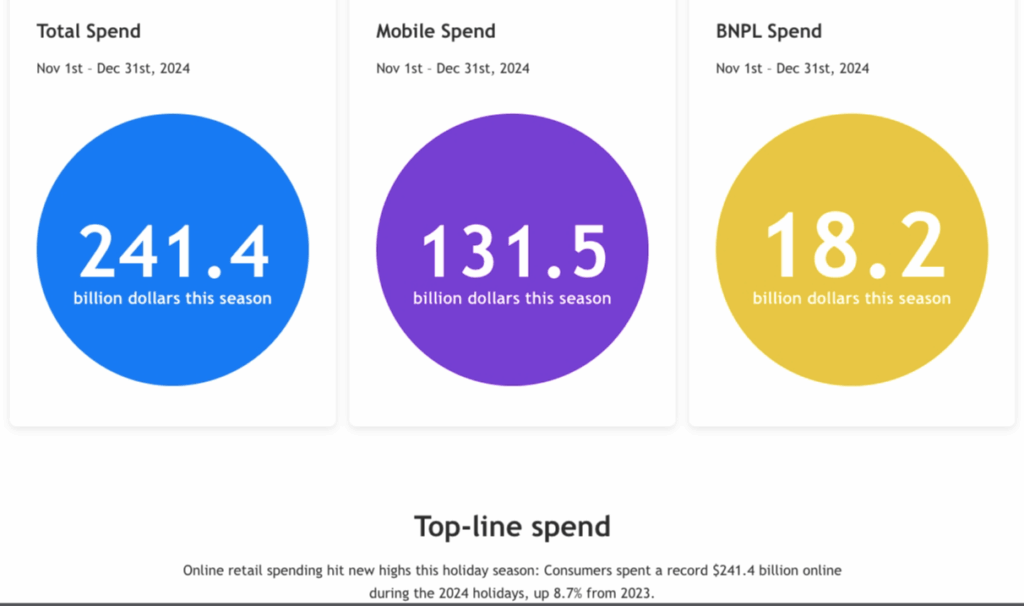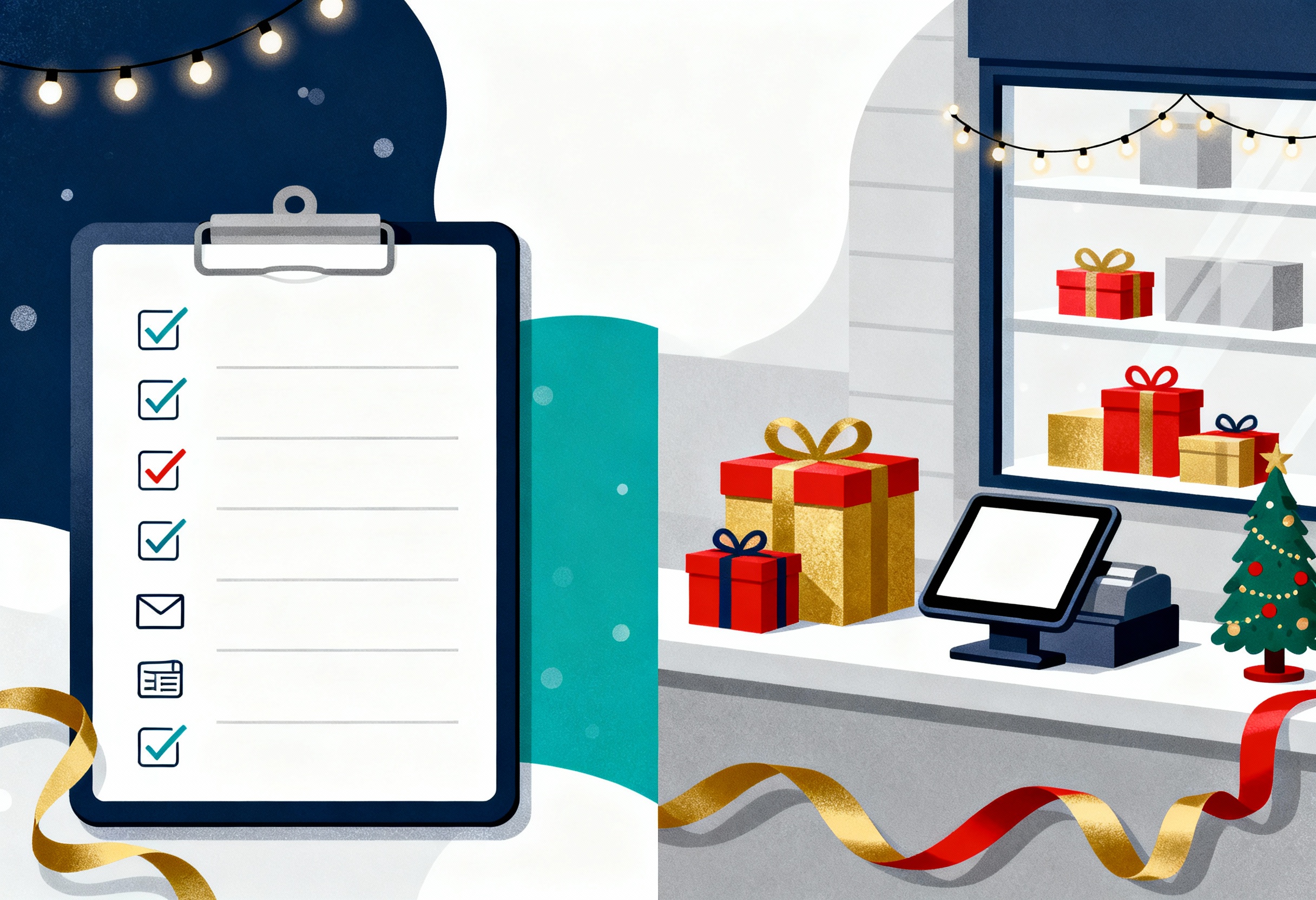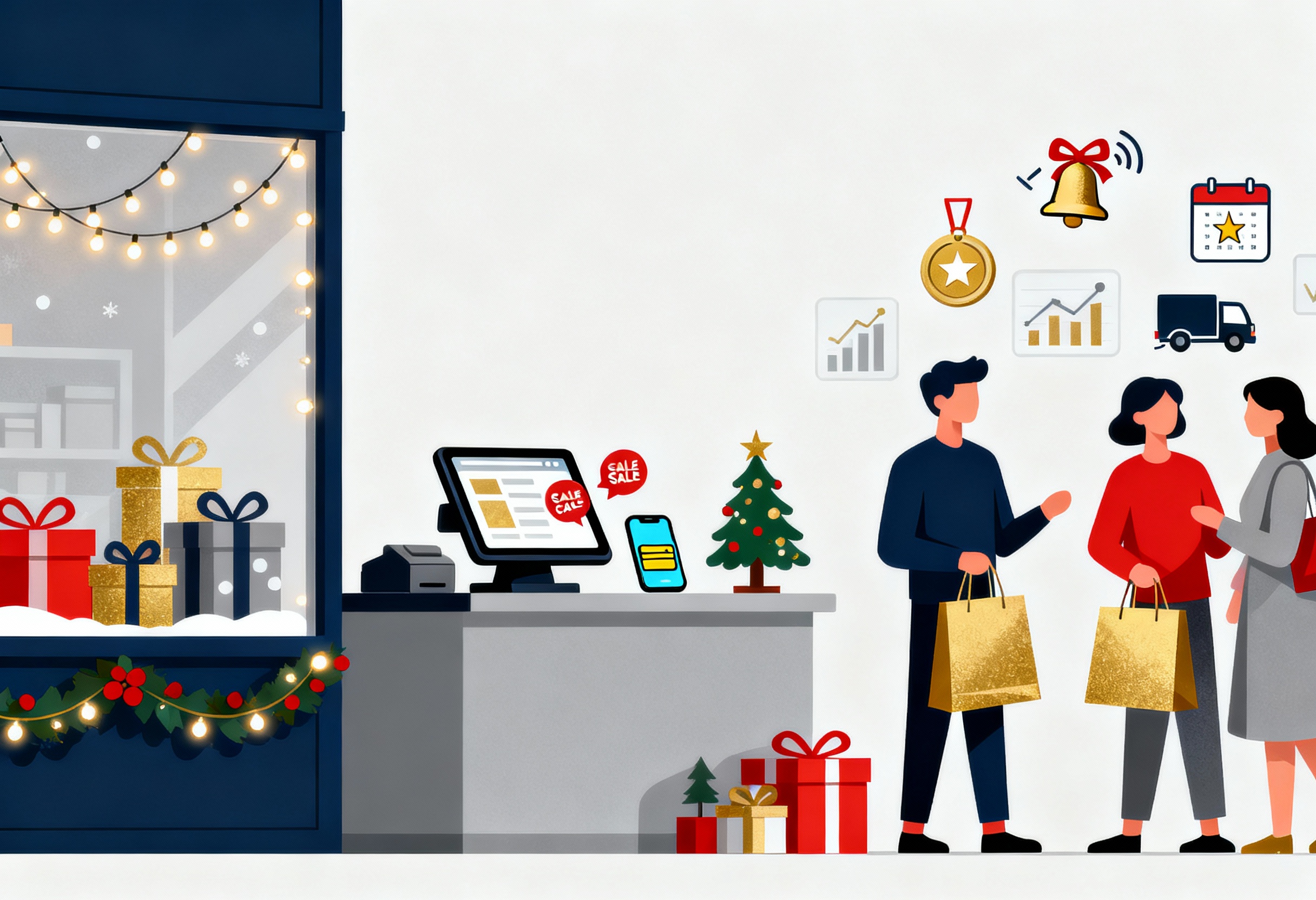Q4 is a goldmine, but only for brands that come prepared. Without a strong holiday marketing ecommerce strategy, campaigns fall flat, margins shrink, and your team scrambles. This guide from ConnectPOS breaks down what that strategy actually looks like in action: the tools, the timing, and the tech that turns year-end chaos into big wins.
Highlight
- Plan before the rush. Successful holiday campaigns begin in July or August, not November.
- Personalization drives performance. Segmented offers based on real customer data beat blanket discounts every time.
- Execution needs alignment. Strong holiday strategies connect marketing, operations, and fulfillment across all touchpoints.
What Is a Holiday Marketing Ecommerce Strategy?
A holiday marketing ecommerce strategy is a short-term, high-pressure sales plan built for peak season. It blends data, planning, and execution to help retailers grab attention, drive traffic, and close sales fast. During the 2024 season alone, U.S. shoppers spent a record $241.4 billion online, up 8.7% year over year, according to Adobe Analytics.

Unlike evergreen campaigns that run year-round, holiday strategies work on a compressed clock. The stakes are higher. Deadlines are tighter. The window to win or miss is weeks, not months.
Cyber Monday 2024 illustrated the pace, pulling in $13.3 billion in a single day and peaking at $15.8 million per minute between 8 p.m. and 10 p.m.
Success depends on knowing your audience early and building campaigns that move quickly. That means digging into customer data, building a campaign calendar, and syncing touchpoints across email, social, and your site.
But it’s not just about promotions. Operational prep is just as key, stock accuracy, fast checkout, trained staff, and clear returns all shape the shopper’s experience.
Spot container rates from the Far East to the U.S. West Coast jumped 144% between late April and early July 2024, pressuring fulfillment costs for brands that failed to secure capacity in advance.
Think of it like this: a solid holiday strategy isn’t one thing. It’s many things working together, at the right time, without falling apart.
Why Your Store Needs a Strong Holiday Marketing Ecommerce Strategy in 2025
The holiday season isn’t just another sales bump. The National Retail Federation tallied U.S. core retail sales at up to $989 billion for November–December 2024, the highest on record. That’s not a seasonal trend. It’s survival.
What’s changed is how early shoppers start. October is no longer the warm-up. It’s game time. McKinsey’s Consumer Pulse shows most buyers now kick off in October or earlier, leaving only 40% who wait until November. Brands waiting until mid-November miss out on buyers who’ve already clicked ‘order’ elsewhere.
►►► Optimal solution set for businesses: Multi store POS, Next-gen POS, Inventory Management Software (MSI), Self Service, Automation, Backorders
Paid ads get pricier each year. CPCs climb, ROAS dips, and last-minute bids burn budgets. Reuters found the cost-per-click for the keyword “Walmart clothes” skyrocketed 16-fold ahead of Black Friday 2024 as Temu and Shein out-bid rivals. A planned holiday marketing ecommerce strategy protects your margin and your team’s sanity.
And this isn’t just about a one-time sale. Done right, holiday campaigns feed your loyalty loop. They bring in first-timers, win back old shoppers, and increase customer lifetime value.
But there’s a catch. Shoppers expect more. They want deals, yes but also fast shipping, smooth checkout, real-time stock info, and responsive support. If your backend isn’t ready, even the best campaign falls flat.
A strong holiday plan connects marketing with operations, not just offers with emails. That’s how you win during Q4, without losing control of everything else.
What a Strong Holiday Marketing Ecommerce Strategy Actually Looks Like
Good holiday campaigns don’t run on guesswork. They’re planned, tested, and flexible enough to shift when something goes sideways. A strong holiday marketing ecommerce strategy doesn’t just rely on big discounts. It connects the dots between planning, personalization, promotion, fulfillment, and follow-up.
We’ll break down what that looks like in practice.
Plan Early and Build a Holiday Calendar
Every strong campaign starts well before the holidays. Brands that prep early avoid the rush and run smoother campaigns. Forbes estimates total global holiday ad spend will hit $271.6 billion in Q4 2024, up 9.5% from the prior year, rewarding the marketers who lock budgets first.
- Review past performance: Check what worked last year and what fell flat. Do this by July or August.
- Mark every key holiday: Add Singles Day, Black Friday, Cyber Monday, Green Monday, Christmas, Boxing Day, and even niche events like back-to-school.
- Set milestones: Plan for early-bird promos, main-event pushes, last-chance deals, and post-holiday loyalty nudges.
A calendar gives structure. Without one, things slip through the cracks.
Use Data & Personalization to Drive Offers
Generic emails and flat discounts feel lazy. Shoppers want relevance and rewards that match their habits. U.S. e-commerce already represents 16.2% of total retail sales, per the Census Bureau, so brands have ample behavioral data to fuel those custom offers.
- Track shopper behavior: Use browsing history, abandoned carts, wishlist data, and purchase history.
- Group by type: VIPs get early access. Lapsed customers get win-back deals. New ones get welcome incentives.
- Customize deals: Run flash sales for high-converting products. Use BOGO for slower items. Test free shipping or gift bundles.
Personalization isn’t a luxury anymore. It’s the baseline. You’ll need a POS system that includes CRM POS features to tailor experiences at scale.
Build FOMO and Urgency
People shop faster when they feel they might miss out. Amazon’s July 2025 Prime Day drove $24.1 billion in U.S. online spend, a 30.3% year-over-year leap, proving how limited-time events move buyers en masse. But this only works when done right, not when every message screams SALE.
- Create countdowns: Add timers to landing pages, emails, or promo bars.
- Show scarcity: Highlight limited stock, limited-time drops, or exclusive bundles.
- Push action: Use strong CTAs like “Ends Tonight” or “Only 3 Left.”
- Extend your window: Don’t limit promos to one weekend. Longer campaigns lower pressure and catch late shoppers.
Urgency done well creates momentum. Urgency done poorly looks like spam.
Execute Across Omnichannel
Shoppers don’t think in “channels.” They just see your brand. Your strategy should feel the same everywhere. Nielsen logged nine separate December 2024 days with over 100 billion TV viewing minutes. This shows the need to sync creative across screens when attention soars.
- Keep promos consistent: Align messaging and discounts across email, SMS, your website, and paid ads.
- Support with visuals: Create matching banners, seasonal packaging, and curated gift guides.
- Use content creators: Partner with influencers or gather UGC. Reels, TikToks, and reviews drive trust fast.
- Run retargeting: Show cart abandoners the exact items they left behind with dynamic ads on Instagram or Google.
The message doesn’t need to be loud. It just needs to be clear and everywhere.
Prepare Operations and Customer Experience
Big campaigns fall apart when ops aren’t ready. Broken checkouts and missed orders ruin everything you built. With West-Coast container spot rates more than doubling mid-year, logistics costs can balloon if brands delay inventory moves.
- Test your website: Make sure it loads fast, works on mobile, and handles traffic spikes.
- Sync your inventory: Real-time updates stop overselling and backorder chaos.
- Train your team: Seasonal staff should know returns, promos, and how to solve common problems fast.
- Make returns painless: Offer exchanges, loyalty points, or simple online returns.
Operations and CX aren’t afterthoughts. They are the campaign.
Analyze Performance and Follow-Up
The job isn’t done after the last package ships. That’s when the next strategy starts. Adobe recorded $41.1 billion in online spend during Cyber Week 2024, or 17% of the full season’s total, highlighting how post-event insights shape Q1 planning.
- Watch live data: See what promos work, where users drop off, and which channels convert.
- Change fast: Shift spend or creative mid-campaign if something flops.
- Review the results: Find your strongest products, best customers, and biggest gaps.
- Use the insights: Feed those lessons into Q1 campaigns, welcome flows, and loyalty pushes.
Holiday campaigns don’t just bring in sales. They shape how you sell for the next six months.
Common Mistakes That Hurt Your Holiday Marketing Results
A great holiday marketing ecommerce strategy doesn’t just focus on what to do. It avoids the common traps that kill performance.
- Launching too late means missing early-bird shoppers who finished their lists before Black Friday even started.
- Relying only on blanket discounts without segmentation wastes ad dollars and lowers perceived value. VIPs expect more than a 10% code.
- Breaking the customer journey across email, site, and ads leads to confusion. If one touchpoint is out of sync, the whole campaign feels off.
- Ignoring backend operations causes stockouts, missed orders, and long support queues. No promo can fix a bad fulfillment experience.
These mistakes don’t just lose sales. They lose trust and that’s harder to win back than any holiday revenue spike.
Holiday Marketing Ecommerce Strategy Tools That Actually Work
Even the best ideas fall apart without the right tools. A smart holiday marketing ecommerce strategy relies on more than just discounts. It’s about keeping every part of the plan connected and moving.
- Planning tools: Use Notion, Trello, or shared Google Sheets to map campaigns, assign tasks, and track timelines.
- Segmentation & email: Tap into Klaviyo, loyalty lists, or simple customer tagging to send smarter messages, not just more of them.
- Urgency builders: Add countdown banners, low-stock notices, or flash deal labels to landing pages and product cards.
- Data & analytics: Watch what matters. Use GA4, heatmaps, and real-time dashboards to spot what’s working and what’s falling flat.
- POS system: Sync inventory, orders, and promotions across online and offline channels. When shoppers bounce between website and store, your backend shouldn’t miss a beat. That’s where having a Next-gen POS solution helps.
Planning tools, segmentation, urgency builders, analytics dashboards, and a modern POS keep the operation humming. During Prime Day 2025, paid search alone captured 28.5% of online sales, TechCrunch notes. This shows why tight data feeds and attribution matter.
ConnectPOS – Your POS Engine for a Winning Holiday Marketing Ecommerce Strategy
When holiday orders start flooding in, slow tech can’t keep up. ConnectPOS is built to handle the chaos so your campaigns don’t miss a beat.
- Real-time inventory sync: Stay accurate across all channels, no overselling, no backorders. Every product, every location, updated instantly.
- Promotion-ready tools: Run campaigns with ease. Set discounts by product, schedule flash deals, or offer special pricing to VIPs or first-time buyers.
- Fast, flexible checkout: Speed matters. Use barcode scanners, split payments, custom gift receipts, and shortcut keys to fly through lines.
- Offline selling mode: Even if your internet drops, your sales don’t. Orders sync once you’re back online.
- Click-and-collect and ship-from-store: Offer more ways to buy. Let customers shop online and pick up in-store or fulfill from the nearest location.
- Integratable with loyalty and gift card support: Keep customers coming back with easy rewards and festive gift card options.
- Live data dashboards: Know what’s selling in real time. Shift promos, restock fast, and spot high-performing products on the fly.
- Staff & store management: Add seasonal staff with role-based access. Control permissions and track performance across every branch.
- Ensure seamless platform integration: Use Shopify POS or Magento POS from ConnectPOS, perfect for merchants looking to unify their eCommerce backend across multiple channels during peak seasons.
Your holiday marketing ecommerce strategy needs more than ideas. It needs the right tech backing it up. That’s where ConnectPOS comes in, your all-in-one system for smoother sales, stronger campaigns, and happier holiday shoppers.
FAQs: Holiday Marketing Ecommerce Strategy
1. When should holiday marketing planning begin?
Start by July or August so your campaigns go live by early October.
2. What’s one thing stores often get wrong?
Launching too late and offering the same deal to everyone.
3. How many channels should I use?
Focus on 2–3 main ones, but make sure they’re consistent and connected.
4. How can I measure the success of my holiday marketing ecommerce strategy?
Track metrics like sales lift, conversion rate, AOV, new vs. returning customers, and campaign ROI.
5. What’s the best way to prepare for sudden traffic spikes during the holidays?
Stress-test your website, use real-time inventory syncing, and have backup support plans in place.
Final Thoughts
A strong holiday marketing ecommerce strategy doesn’t just sell more. It keeps customers happy, teams focused, and operations steady when everything gets loud. The brands that win Q4 aren’t always the loudest. They’re the most prepared. From planning and promos to backend and fulfillment, every part needs to click. And when it does, shoppers feel it.
ConnectPOS helps bring that all together. So when your holiday campaigns go live, everything runs like it should, online, in-store, and everywhere in between. Need a smoother holiday season? Contact us today.
►►► Optimal solution set for businesses: Shopify POS, Magento POS, BigCommerce POS, WooCommerce POS, NetSuite POS, E-Commerce POS



